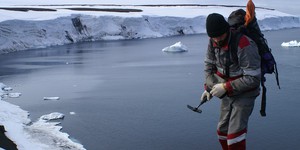Summary
Sabine De Brabandere, PhD, Science Buddies
If you want a Project Idea with full instructions, please pick one without an asterisk (*) at the end of the title.
Abstract
Have you ever wondered how it's possible to so accurately date ancient artifacts? Geologists, paleontologists, archeologists, and anthropologists use a statistical process like radioactive isotope decay to date objects through a method called radioactive dating (also known as radiometric dating). To learn more about that method, check out the geology science project How Old Is That Rock? Roll the Dice & Use Radiometric Dating to Find Out. In that particular Project Idea, radioactive decay of isotopes is modeled by rolling dice. While that procedure is a great way to grasp the concept, it would certainly be a time-consuming and tedious process in the real world, even with samples of only 100 dice, which could scarcely be called a "large number." Furthermore, how many trials of rolling up to 100 dice over and over again—while accurately keeping track of the results—would you be willing to do by hand? The most motivated student will only get to a pretty small number of trials. Why not get the help of a computer to do this repetitious work for you?A computer program can help you create a simulation of what would happen in real life. In this Abbreviated Project Idea, you will simulate the decay of radioactive isotopes. To get started, do you know how to program a random event like rolling a die or a decaying isotope? The tool you will use for this is called a pseudorandom number generator, which creates almost-random numbers on a computer. This will set you on the path to generating a radioactive decay curve on your computer. At the end of this Abbreviated Project Idea, you'll find some suggestions on how you can incorporate this information into a computer science project.
As you roll a standard six-sided die, you know each number from 1–6 has an equal chance, or probability, to land on top; but you cannot predict which exact number it will be on your roll. This type of process is called a random process. So how can you generate a sample of random numbers by using a perfectly logical machine like a computer? Most programming languages have a random number generator. This is a function that will provide you with an almost-random (or pseudorandom) number. Check out the references provided in the Bibliography section to get a feel for the difference between true randomness and computer-generated randomness, as well as some information about how computers generate these numbers. To test whether or not these pseudorandom numbers can help generate the outcome of rolling dice or predict how isotopes decay, start by looking up the random number generator function for your choice of programming language and read trough its specifications. As an example, in Microsoft® Excel® (a spreadsheet program), RAND() generates a random real number between 0 and 1. The RAND() function in Excel clearly is not going to do the job. You might be lucky; the programming language of your choice might be able to provide a random integer between 1 and 6—exactly what you would get from rolling one die. If not, do you know how to translate a random real number between 0 and 1 to a random integer between 1 and 6?
The algorithm below will guide you to the formula.
- First, transform the random real number between 0 and 1 to a random real number between 1 and 7. You can do this by multiplying the generated number by 6 and adding 1, as shown in the formula below:
Formula 1:
Can you verify this result in a random real number between 1 and 7?
- Then, round this number down to its nearest integer. In Excel, the function INT will do this for you. You can program this functionality yourself, or look up the function for rounding in your choice of programming language. Formula 2, below, lists the final formula for Excel.
Formula 2:
Can you verify this result is a random integer number between 1 and 6?
Now you only have to execute this formula 100 times, and store the numbers, to generate a sample of numbers you might get by rolling 100 dice.
The geology science project How Old Is That Rock? Roll the Dice & Use Radiometric Dating to Find Out can help you translate the result of rolling 100 dice to the decay of 100 isotopes and explains how to add a time component and how to generate a decay curve.
Start by generating a decay curve for an isotope that decays with a chance of 1/6 in 1 time unit.
Here are some suggestions to expand your exploration:
- Investigate how the decay curve changes when you use a larger number of initial isotopes to generate your decay curve.
- Investigate how the decay curve changes as the decay probability of your isotope changes. What does it look like for a short-lived isotope (an isotope with a higher probability of decaying in 1 time unit) or a long-lived isotope (an isotope with a lower probability of decaying in 1 time unit)?
- Some isotopes have several decay paths; they decay with a specific probability to one daughter isotope, and with a different probability to a different daughter isotope. As an advanced challenge, can you change the model to accommodate for these decay patterns? Can you graph a decay curve and make predictions using these decays?
- Some isotopes have a decay chain; they decay with a specific probability to a first daughter isotope, which in turn is unstable and decays with a specific probability into a final (stable) isotope. As another advanced challenge, can you change the model to accommodate for this decay pattern? Can you graph a decay curve for these decays?
Bibliography
- Random.org. (n.d.). Introduction to Randomness and Random Numbers. Retrieved April 22, 2013.
- HowStuffWorks. (n.d.). How can a totally logical machine like a computer generate a random number?. Retrieved April 21, 2013.
Ask an Expert
Careers
If you like this project, you might enjoy exploring these related careers:








